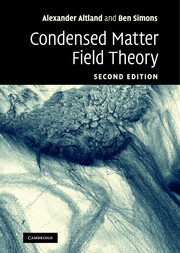Book contents
- Frontmatter
- Contents
- Preface
- 1 From particles to fields
- 2 Second quantization
- 3 Feynman path integral
- 4 Functional field integral
- 5 Perturbation theory
- 6 Broken symmetry and collective phenomena
- 7 Response functions
- 8 The renormalization group
- 9 Topology
- 10 Nonequilibrium (classical)
- 11 Nonequilibrium (quantum)
- Index
3 - Feynman path integral
Published online by Cambridge University Press: 04 August 2010
- Frontmatter
- Contents
- Preface
- 1 From particles to fields
- 2 Second quantization
- 3 Feynman path integral
- 4 Functional field integral
- 5 Perturbation theory
- 6 Broken symmetry and collective phenomena
- 7 Response functions
- 8 The renormalization group
- 9 Topology
- 10 Nonequilibrium (classical)
- 11 Nonequilibrium (quantum)
- Index
Summary
The aim of this chapter is to introduce the concept of the Feynman path integral. As well as developing the general construction scheme, particular emphasis is placed on establishing the interconnections between the quantum mechanical path integral, classical Hamiltonian mechanics, and classical statistical mechanics. The practice of path integration is discussed in the context of several pedagogical applications. As well as the canonical examples of a quantum particle in a single and a double potential well, we discuss the generalization of the path integral scheme to tunneling of extended objects (quantum fields), dissipative and thermally assisted quantum tunneling, and the quantum mechanical spin.
In this chapter we temporarily leave the arena of many-body physics and second quantization and, at least superficially, return to single-particle quantum mechanics. By establishing the path integral approach for ordinary quantum mechanics, we will set the stage for the introduction of field integral methods for many-body theories explored in the next chapter. We will see that the path integral not only represents a gateway to higher-dimensional functional integral methods but, when viewed from an appropriate perspective, already represents a field theoretical approach in its own right. Exploiting this connection, various concepts of field theory, namely stationary phase analysis, the Euclidean formulation of field theory, instanton techniques, and the role of topology in field theory, are introduced in this chapter.
The path integral: general formalism
Broadly speaking, there are two approaches to the formulation of quantum mechanics: the “operator approach” based on the canonical quantization of physical observables and the associated operator algebra, and the Feynman path integral.
Information
- Type
- Chapter
- Information
- Condensed Matter Field Theory , pp. 95 - 155Publisher: Cambridge University PressPrint publication year: 2010
